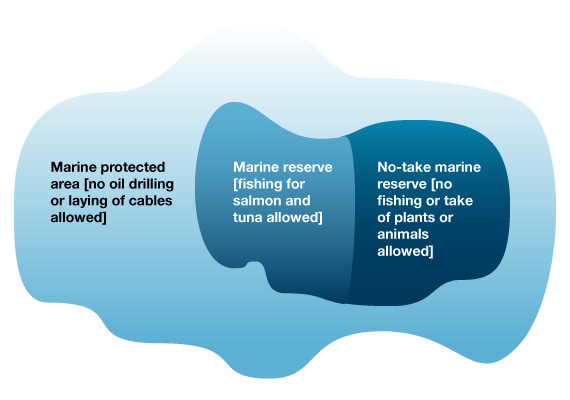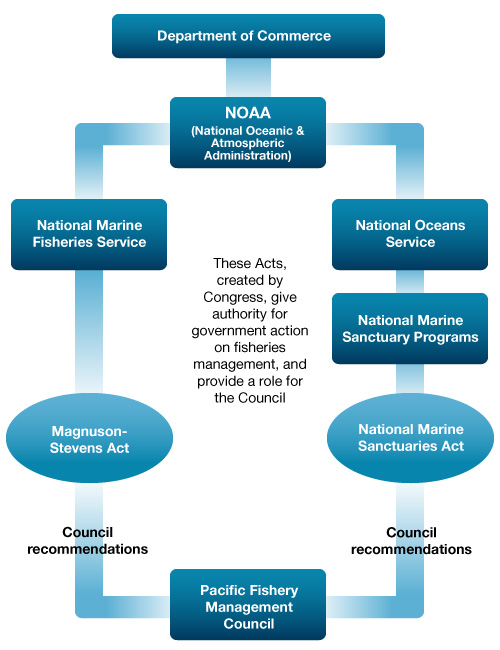Marine Protected Areas

Marine Protected Areas (MPAs) are broadly defined as ocean, estuarine, or (in some cases) freshwater areas that have been designated to provide protections for natural or cultural resources. In the fisheries world, this typically means an MPA is designed to protected important habitat features, or to provide a refuge for marine species. The umbrella term of MPA includes related management areas such as marine reserves and fisheries conservation areas. MPAs do not inherently include any restrictions or management measures, although they almost always include some form of restrictions to protect the resources therein.
Marine reserves are a subset of MPAs, and are typically more restrictive, often including complete restrictions on fishing or removing natural resources (“no-take” marine reserves). Marine reserves can be designated to conserve sedentary species (those that stay in place) or to hedge against scientific uncertainty. They are particularly helpful for sedentary species that produce more offspring as they get older, like most rockfish. Fishery conservation areas are typically put in place to protect specific stocks or assemblages from fishing mortality. In both cases, they fall under the general definition of MPA, and are created for specific conservation purposes such as habitat protection or stock recovery.
MPAs have educational and research value as well as a conservation benefit. To successfully manage these resources, managers need better knowledge of the biology, habits, and behaviors of fish stocks and the ecosystems that support them. And public outreach and education efforts also serve to inform the public. The Marine Conservation Institute’s MPA Atlas includes a comprehensive list of MPAs around the world. The NOAA MPA Center also includes many MPA-related resources.

How does the Council use MPAs?
The Council employs several variations of MPAs, including areas closed for habitat protection, for species conservation, and for bycatch reduction. Most involve the groundfish fishery, since the gear used in that fishery is more likely to affect habitat than the gear used in other Council fisheries. Often, a closure designed for one purpose will have other benefits. For example, the Council’s bottom trawl rockfish conservation area (RCA) was designed to minimize mortality of overfished groundfish species. However, during the 16 years the bottom trawl RCA was in place, the habitats in those areas benefited from being largely untouched by bottom trawl gear. See the “Area Closures” fact sheet for a summary of closed areas developed by the Council and NMFS.
Essential Fish Habitat Conservation Areas (EFHCAs) are designed to protect benthic (ocean floor) habitats from groundfish bottom trawling or other bottom contact fishing gear. The configuration of EFHCAs was revised under Groundfish FMP Amendment 28. It includes the ‘bottom trawl footprint’ closure in waters deeper than 700 fathoms.
The Council’s deepwater closure uses the Council’s Federally-granted authority to close waters deeper than 3500 meters to all bottom contact groundfish gear, primarily to protect deep sea corals and sponges.
The Cowcod Conservation Area (CCA) is a large area in the Southern California Bight closed to bottom trawl fishing gear. It was designed to minimize mortality on cowcod after it was declared an overfished species.
State MPAs and Marine Reserves
Within the three-mile state waters boundary, coastal states have authority to establish MPAs, including marine reserves and no-take marine reserves. Numerous MPAs have been established in state waters all along the West Coast, including in Puget Sound, Washington. The purposes include research, species conservation, and protection of sensitive intertidal areas.
Council authority over MPAs
The Council’s authority over MPAs rests in its fishery management authorities under the Magnuson-Stevens Act (MSA), the primary act that oversees fisheries management in the United States. Councils may close areas to certain fishing gears, establish seasonal closures, or take other actions for habitat protection or species conservation. Under the MSA, the Council proposes regulations for review, approval, and implementation by National Marine Fisheries Service.
While the Council can recommend the creation of MPAs under its MSA authority, it has limited ability to protect fish and habitat in the MPA from anything other than fishing impacts. For example, it does not control dredging, dumping, or other potentially damaging activities. However, the Council can comment to state and Federal agencies about actions that may harm marine reserve areas. One example would be if an agency wanted to issue a permit for dumping dredge materials in fish habitat.
Councils also have authority to recommend fisheries management measures in National Marine Sanctuaries when a sanctuary is established under the National Marine Sanctuaries Act. National Marine Sanctuaries have broad authority to establish management measures and rules within the sanctuary boundaries, but they do not have authority to regulate fishing activities. The Pacific Council and the West Coast sanctuaries work cooperatively to share relevant information and address common issues when appropriate.
For more information on the Council’s consideration of marine reserves, please contact Kerry Griffin.